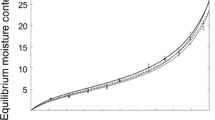Summary
The heating of solid wood to higher temperatures is the simplest and cheapest means for stabilizing its dimensions. Caused by the partial thermal degradation of the chemical components of the wood occurring in heat stabilization, also other physical properties are considerably changed. For the investigation of the effect of thermal treatment on the sorption of the wood, oven-dry samples of beech-wood, vakwood, and pine sapwood were heated in presence of air at temperatures of 70°–200°C for different periods (6, 24, and 48 hours). Subsequently, for these samples the adsorption and desorption isotherms were taken up at 20°C in a vacuum-sorption apparatus, and there from the avarage sorption of the woods was determined. When heated at 70°C the sorption capacity of the three woods was not changed. The thermal treatments at 100°, 130°, and 150°C resulted in a decrease in the sorption capacity, being the greater the higher the temperature and the longer the time of heating were. The heating-treatments of 6 and 24 hours at 180°C yielded, in an equal sense, even greater decreases in the sorption capacity, though after 48 hours of heating the decrease was less than after 24 hours. During the interval of 24 to 48 hours at 180°C, consequently chemical processes must have taken place in the woods now resulting in a rise of the sorption capacity. This should have been caused by the sampleting of the lignin. The determined changes in the sorption of the heat-treated woods are explained by the sorption behaviour of the chemical wood components cellulose, wood polyoses, and lignin and their proportions in the chemical composition of the wood as well as their different thermal stability.
Similar content being viewed by others
Schrifttum
Runkel, R. O. H., u. M. Lüthgens: Studien über die Sorption der Holzfaser. Zweite Mitteilung: Untersuchungen über die Heterogenität der Wassersorption der chemischen und morphologischen Komponenten verholzter Zellwände. Holz als Roh- und Werkstoff Bd.14 (1956) S. 424/441.
Christensen, G. N., u. K. E. Kelsey: Die Sorption von Wasserdampf durch die chemischen Bestandteile des Hölzes. Holz als Roh- und Werkstoff Bd.17 (1959) S. 189/203.
Runkel, R. O. H.: Zur Kenutnis des thermoplastischen Verhaltens von Holz. Erste Mitteilung. Holz als Roh- und Werkstoff Bd.9 (1951) S. 41/53.
Runkel, R. O. H., u. K. D. Wilke: Zur Kenntnis des thermoplastischen Verhaltens von Holz.—Zweite Mitteilung. Holz als Roh- und Werkstoff Bd.19 (1951) S. 260/270.
Wilke, K. D.: Untersuchungen über die thermische Plastifizierung von Holz. Diss. Univ. Hamburg 1951.
Stamm, A. J.: US Pat. 2296 316 (1942).
Stamm, A. J., H. K. Burr, u. A. A. Kline: Stabywood … Heat-Stabilized Wood. Ind. Eng. Chem. Bd.38 (1946) S. 630/634.
Stamm, A. J.: Thermal Degradation of Wood and Cellulose. Ind. Eng. Chem. Bd.48 (1956) S. 443/447.
Seborg, R. M., M. A. Millett u. A. J. Stamm: Heat-Stabilized Compressed Wood (Staypak). U. S. For Prody. Labor. Report No. 1580. Madison 1944: USFPL.
Nagrodsski, L. A.: Bezichungen des Holzes zum Wasser und seine physikalischen Eigenschaften, in: N. I. Nikitin: Die Chemie des Holzes. Berlin 1955: Akademie-Verlag.
Tiemann, H. D.: Does Temperature Injure Wood? South. Lamberman Bd.163 (1941) Nr. 2047, S. 49/50 u. Nr. 2049, S. 49/51.
Seborg, R. M., H. Tarkow u. A. J. Stamm: Effect of Heat Upon the Dimensional Stabilization of Wood. J. Forest Products Research Soc. Bd.3 (1953) S. 50/67.
Goos, N. W.: The Thermal Decomposition of Wood in L. E. Wise u. E. C. Jahn Wood Chemistry, II., Bd., 2 Aufl. New York 1933: Keinhold Publishing Corp.
Ponomarjew, A. N.: Thermische Zersetzung des Holzes, in N. L. Nikittin. Die Chemie des Holzes. Berlin 1933: Akademie Verlag.
Kollmann, F.: Technologie des Holzes und der Holzwerkstoffe. I. Bd. 2. Aufl. Berlin Göttingen/Heidelberg 1931: Springer.
Kollmann, F.: Technologie des Holzes und der Holzwerkstoffe. II. Bd. 2. Aufl. Berlin/Göttingen/Heidelberg 1955: Springer.
Egner, K.: Neuere Erkenntnisse über die Vergütung der Holzeigenschaften. Mitt. Fachanssch. Holzfragen H. 18, S. 2/3. Berlin 1937.
Kollmann, F.: Technologie des Holzes und der Holzwerkstoffe, I. Bd. 2. Aufl. (1951), S. 396 ff.
Barkas, W. W.: Swelling Stresses in Gels. Dept. Sci. Ind. Res. For. Prod. Res. Spec. Rep. Nr. 6. London 1945.
Wislicenus, H.: Neue Wege der stoftlichen Holznutzung und Holzforschung. Z. VDI Bd.74 (1930) S. 1469/1478.
Kollmann, F.: Zur Theorie der Sorption. Forschung auf dem Gebiete des Ingenieurwesens Bd.29 (1963), Nr. 2.
Stamm, A. J.: Verfahren zur Abschätzung der Wasserdampfsorption am Fasersättigungspunkt von Holz und Papier. Holz als Roh- und Werkstoff Bd.17 (1959) S. 203/205.
Kollmann, F., u. A. Schneider: Ernrichtungen zur praxisnahen und wissenschaftlich exakten Messung der Sorptionseigenschaften von Holz und Holzwerkstoften. Holz als Roh- und Werkstoff Bd.16 (1958) S. 117/122.
Schneider, A.: Neue Diagramme zur Bestimmung der relativen Luftfeuchtigkeit über gesättigten wasserigen Salzlösungen und wässeringen Schwefelsaurelosungen bet versclatedenen Temperaturen. Holz als Roh- und Werkstoft Bd.18 (1960) S. 269/272.
Stamm, A. J.: Surface Properties of Cellulosic Materials, in: I. E. Wise u. E. C. Jahn: Wood Chemistry, II. Bd., 2. Aufl. New York 1955: Reinhold Publishing Corp.
Asplund, A., Die Defibrator Methode und ihre Anwendungsgebiete. Wochenbl. f. Papierfabrikation Bd71 (1940) S. 590/595.
Ögland, N. J.: Ohn värmebehandling av harda tränberskivor. Norsk Skogindustric Bd.2, (1948) Nr. 11, S. 301.
Trendelenburg, R.: Das Holz als Rohstoff, München 1939: J. F. Lehmanns Verlag.
Additional information
Mitteilung aus dem Institut für Holzforschung und Holztechnik der Universität München
Rights and permissions
About this article
Cite this article
Kollmann, F., Schneider, A. Über das Sorptionsverhalten wärmebehandelter Hölzer. Holz als Roh-und Werkstoff 21, 77–85 (1963). https://doi.org/10.1007/BF02609705
Issue Date:
DOI: https://doi.org/10.1007/BF02609705




